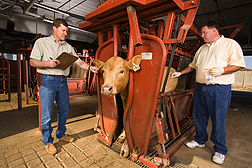Meat Safety Success Story
It All Works Out in the Wash
|
|
Leafy vegetables aren’t the only foods to benefit from ARS food safety research. U.S. beef has also made great strides––thanks in large part to studies conducted by scientists at the Roman L. Hruska U.S. Meat Animal Research Center (USMARC) in Clay Center, Nebraska.
Following a 1993 outbreak, the USMARC scientists launched a massive investigation into E. coli O157:H7. Their work has had major benefits for both producers and consumers of U.S. beef. One important finding was that the principal source of E. coli O157:H7 in ground beef is a cow’s hide.
“At the time, most intervention efforts were focused on eliminating E. coli O157:H7 from feces,” says former USMARC director Mohammad Koohmaraie. “Our findings led to a paradigm shift that enabled us to develop hide-targeted intervention techniques to reduce and eliminate pathogenic E. coli O157:H7 and other dangerous microorganisms from the ground beef supply.”
One of the most successful techniques developed at USMARC is a chemical hide-washing system that saves the U.S. beef industry millions of dollars every year. A high-pressure water wash removes excess organic matter from cattle hides, which are then sprayed with an antibacterial compound.
An estimated 40 percent of U.S. feedlot-raised beef cattle undergo the washing treatment, Koohmaraie says. By targeting hides, the technology has reduced the national incidence of E. coli O157:H7-positive ground beef samples by 43.3 percent.
“We have had no problems this year at any of the facilities that use the hide-wash system,” says Timothy P. Biela, chief food safety officer of American Fresh Foods and American Foodservice. The two partner corporations produce more than 350 million pounds of ground beef every year for supermarkets, commercial fast-food outlets, and casual dining. They sample the products every 20 minutes to test for E. coli O157:H7 and conduct more than 15,000 additional tests each year for other pathogens.
So how does hide washing measure up?
“It’s incredibly effective,” Biela reports. “It’s almost unbelievable.”
Read more about this research in the October 2006 issue of Agricultural Research magazine, available online at www.ars.usda.gov/is/AR/archive/oct06/beef1006.htm.—By Laura McGinnis, Agricultural Research Service Information Staff.
This research is part of Food Safety, an ARS national program (#108) described on the World Wide Web at www.nps.ars.usda.gov.
To reach scientists mentioned in this article, contact Laura McGinnis, USDA-ARS Information Staff, 5601 Sunnyside Ave., Beltsville, MD 20705-5129; phone (301) 504-1654, fax (301) 504-1486.
"Meat Safety Success Story: It All Works Out in the Wash" was published in the July 2008 issue of Agricultural Research magazine.







